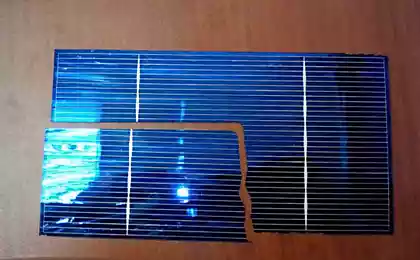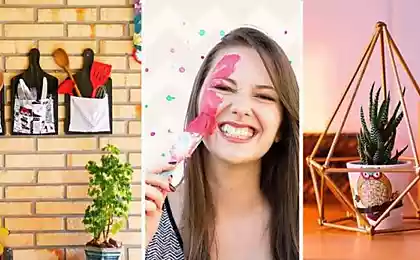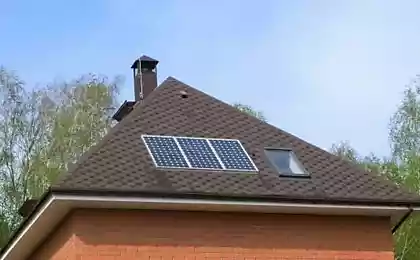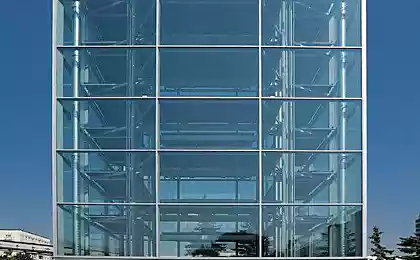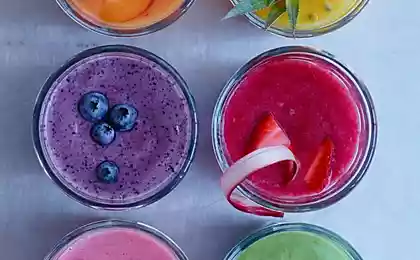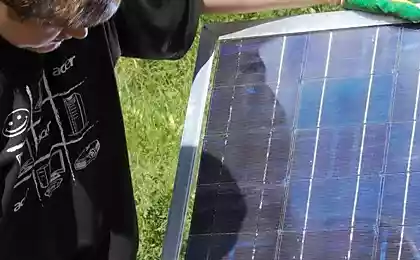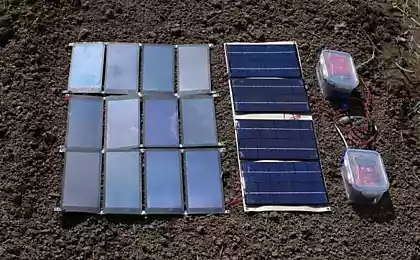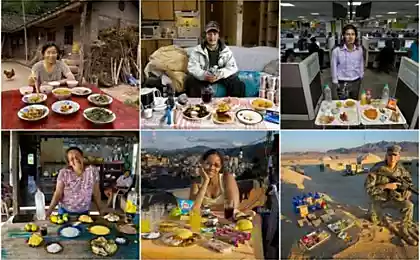2200
Complete energy autonomy or how to survive with solar panels in the province (Part 5. Sunchaser)
The previous parts Part 1
Part 2
Part 2.5
Part 3
Part 4
In the European part of Russia, the sun finally was shining brightly enough and long enough to be able to maintain their autonomous system without external energy- and electricity generators. But there are a few tricks that allow for small modifications of existing systems to collect a little more energy. First - tracking of the sun, the second - tracking the maximum power point of the solar panels. Let's begin with the first and the most interesting - the solar tracker.
"Moped is not mine," but for the understanding of the principle of action is very clearly.
The above tracker you can even приобрести on Ebay . It costs about 52 000 at the end of April 2015 in Russia, and is able to keep a couple of panels with a total capacity of up to 600 watts. And as to the recoverability of solar energy question is very hard, then with the addition of an estimate of the tracker, solar energy will pay off long enough. Therefore, it is great popularity homemade trackers with different management.
should make a remark and assess the feasibility of the installation of the solar tracker. This device allows you to increase the production of energy for the same amount of solar panels in 1, 6 times due to a longer exposure to the sun on the panel and the optimal installation angle of the sun relative to the joint venture. I>
It is necessary to identify the main challenges to be addressed in tracking the sun:
1. Create a sufficiently strong platform that will not only support the weight of the panel, but wind gusts. Tracker with 4-6 or more panels can be considered a great sail.
2. Create the mechanics of turning heavy platform with high sail.
3. Create the control logic of mechanics, to track the sun.
Let's start with the first point. It is advisable to place the array of batteries so that they do not shade each other and fastened a multiple of the required voltage.
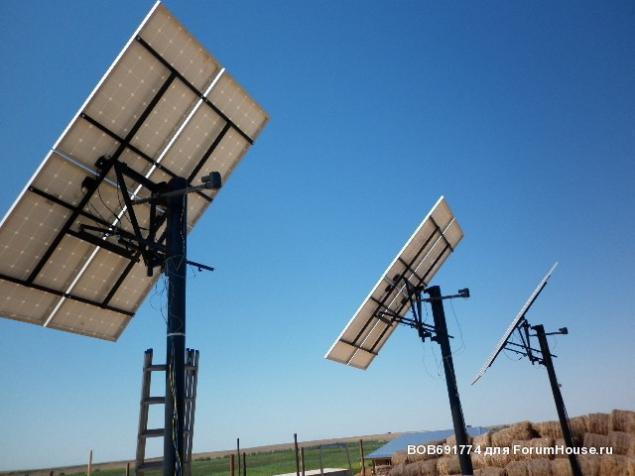
For such a tracker needs a strong foundation and strong iron. Of all the tested devices for controlling the rotary platform best suited actuators. Clearly visible mechanical control at the next picture.
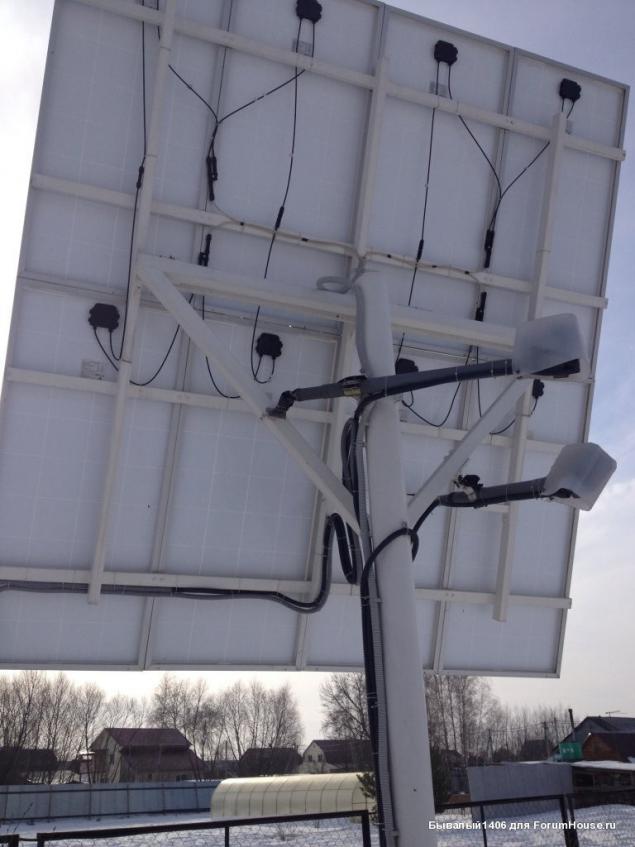
This tracker allows you to control the position of the solar panels in two planes. However, we can only control the horizontal and vertical angle to change a couple of times a year (spring and fall).
With regard to the entire logic system, we can go in several ways:
1. Monitoring of the most striking point
2. Rotate and tilt timer (sunrise and sunset are known and constant for each day)
3. The hybrid version that combines a constant angle of rotation and the search for maximum brightness
The first method can be implemented independently or buy the Chinese ready device. Первый to control the tracker in the same plane
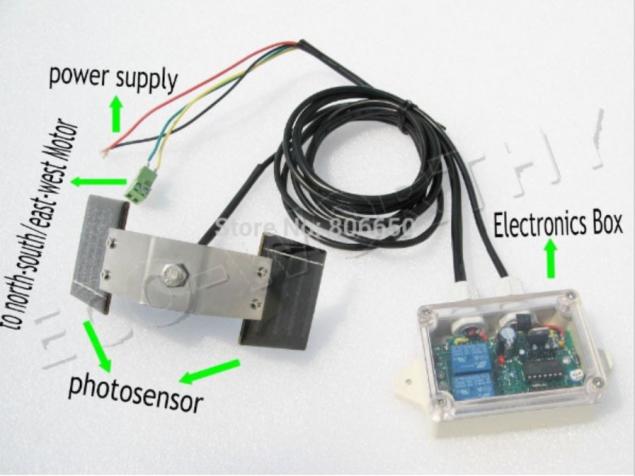
Второй to control the tracker in two planes

Roughly speaking, for tracking the maximum brightness at one point the Chinese want $ 100. It is clear that these systems do not pose much difficulty for a person versed in the principles of operation of the controllers, so a similar system can collect up to 10 times cheaper.
It will look so
Well, the details of the project and implementation can be found here . The project is not mine, so I will not plagiarize.
Detailed information about independent manufacturing solar tracker can be read on profile forums , where empirically calculate the optimal design and the best equipment for the task.
Tracking the maximum power point of solar panels (MPPT)
In the second part of its cycle I was talking about two different types of solar controllers. MPPT (Maximum Power Point Tracking) controller also monitors the sun, but with a different position of the entire system. To give a simple explanation after explanation and schedule.
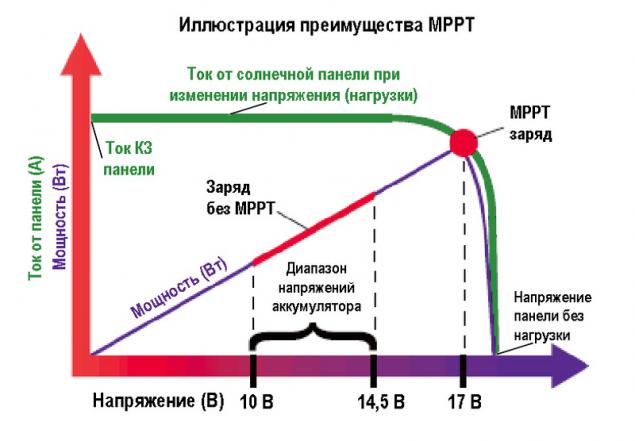
The graph shows that the maximum of output power can be obtained by finding the point of maximum power, which invariably will be on the Green Line. Normal PWM controller simply can not do that. In addition, MPPT controller allows you to connect the assembly of series-connected solar panels. This connection method significantly reduces energy losses during transport from the solar panels to the batteries. The economic feasibility of acquiring MPPT controller appears if more power is established JV 300-400 watts. Based on its experience, I can say that it is necessary to acquire solar controller "for growth", unless the right is not created a powerful energy system that covers the needs of a reserve home. By successive increase in the number of solar panels, I came to power 800 watts - it's not much, but it would be enough for a holiday home in the summer, so that does not apply to electricity. According to my calculator averaged grid will bring from April to August 4 kWh of electricity per day. If you do not use an electric stove and microwave for cooking, then this amount of energy is enough for a comfortable life family of 4 persons. But there is still a powerful electricity eater in a private home in the form of a boiler for hot water. For heating 80 liter boiler need just about 4.5 kWh of electricity. Thus, avtonomka should pay at least for heating water or other service consumers.
In last article I talked about hybrid inverter, which can use the energy priority by solar panels and only pick up the missing from the network. As it relates to a solar controller? The fact that the Russian company MikroArt recently began producing their own MPPT-controllers , which may be associated with the inverters of the same manufacturer for the Common bus. Well, since I have a hybrid inverter is already installed, the new season, I decided to try a new controller.

I must say that it looks brutal regarding the previous two controllers that I already have on my farm. Metal housing, radiators on the sides (Chinese models have radiators on the back wall), dark gray steel case. Recently, I was like that in my household controllers start to "talk" with me in Russian. There used to be an icon, numbers and Latin inscriptions. Can this be considered a whim, but it's nice. Compare in this paper a new controller with the previous models, I will not, but bear with Chinese models tested in a separate text. Perhaps there will examine the feasibility of acquiring a more or less powerful controller, features and reliability.
The biggest advantage of this controller for me - is the ability to swap the right amount of energy that there is no borrowing energy from the battery, which reduces its life. Of the three models, which are presented by the manufacturer, I chose the most popular and the best ratio voltage \ current - ECO Energy Controller MPPT Pro 200/100 . Based on the characteristics of the device can be said that the controller maintains the input voltage to 200 V and an output current of up to 100A. Given the fact that my battery is assembled at 24 V (battery voltage is maintained in 12/24/48/96), the controller will allow to issue a maximum power of 2400 W, that is, I have a two-time reserve capacity of solar panels. The maximum capacity of the controller is 11 kW at 110V Battery (buffer voltage). The controller communicates with the hybrid inverter MAP SIN Energy Pro HYBRID v.1 24V the I2C bus, and can instantly add capacity, when the inverter provides information about the increase in energy consumption. Interaction of two devices one company - it is usually a system to work, so it all comes down to the inclusion of the lace into the right connectors devices and activate the desired option. I was wondering the same manufacturer's declaration that the controller that this MPPT-controller can also instantly add capacity when using the inverter from any other manufacturer. Wondered how it is implemented. Everything was extremely simple:

current sensor hung on the positive wire, leading to the inverter (which is why unimportant inverter manufacturer) and using the эффект Hall controller calculates the power consumption. There have already come into operation logic of the solar controller and it pumps up the right amount of energy. All I know of controllers based on battery voltage, and only considering it, increase the charge current.
Continuing research capabilities of the controller, I was confronted with the fact that it is equipped with three relays, which can be programmed operation. For example, if enough sunshine and no consumption of electric power house, you can start additional heating boiler or the pool. Consider the reverse option: no sun, the battery voltage dropped to critical level where the inverter can simply unplug and power consumption continues. Then you can run a separate benzo \ diesel generator, simply by closing the relay. But for this generator must have run dry contact or a separate system of automatic start-up or SAP (also referred to as the ATS - automatic transfer switch). Because I, like most gardeners, there is a simple Chinese generator, but with the starter, I looked toward the automation of its launch and was delighted to learn that for a long time MikroArt releases its automatic .
Let's go back to the controller. Its installation is standard: first, connect the battery terminals, then connect the terminals of solar panels and used to configure the settings. Connecting an external current sensor, can be observed, which consumes power inverter in real time.
So unwinding wires, install the controller and start saving. The following picture demonstrates the inverter operation in hybrid mode, when only part of the energy consumed by the network, and the primary - from solar panels.

Solar controller specifically connected via an external current sensor to showcase the work of any other inverter, issued third-party vendor.
Summary
Solar controller corresponds to the specs and really pumps up the energy will even connected to the "alien" by the inverter current sensor. Hybrid Inverter really pumps up the network energy from solar panels (photo of 200 watts consumed by half, ie 100 W comes from the sun. Minimum 100W controller will always take away from the network, and the rest is taken from the sun - it is a feature of the device). Simply put, since the connection kit pays for itself began. Unfortunately, spring snowstorm changed dramatically, and in the near future is unlikely to see high efficiency kit (Hybrid Inverter + solar controller), but in May I count on almost full coverage of its energy needs from the sun.
Announcement
The next and final article, I will compare three existing solar controller and I will try to answer all the questions that arose during this cycle of materials. If you remain unsolved any topic and it will be interesting to a large number of Habrochitateley, then I'll try to get together and issue a separate article. And now I am ready to answer questions. Yes, you will arrive with Power of the Sun!
The previous parts Part 1
Part 2
Part 2.5
Part 3
Part 4
Source: habrahabr.ru/post/256049/
Part 2
Part 2.5
Part 3
Part 4
In the European part of Russia, the sun finally was shining brightly enough and long enough to be able to maintain their autonomous system without external energy- and electricity generators. But there are a few tricks that allow for small modifications of existing systems to collect a little more energy. First - tracking of the sun, the second - tracking the maximum power point of the solar panels. Let's begin with the first and the most interesting - the solar tracker.
"Moped is not mine," but for the understanding of the principle of action is very clearly.
The above tracker you can even приобрести on Ebay . It costs about 52 000 at the end of April 2015 in Russia, and is able to keep a couple of panels with a total capacity of up to 600 watts. And as to the recoverability of solar energy question is very hard, then with the addition of an estimate of the tracker, solar energy will pay off long enough. Therefore, it is great popularity homemade trackers with different management.
should make a remark and assess the feasibility of the installation of the solar tracker. This device allows you to increase the production of energy for the same amount of solar panels in 1, 6 times due to a longer exposure to the sun on the panel and the optimal installation angle of the sun relative to the joint venture. I>
It is necessary to identify the main challenges to be addressed in tracking the sun:
1. Create a sufficiently strong platform that will not only support the weight of the panel, but wind gusts. Tracker with 4-6 or more panels can be considered a great sail.
2. Create the mechanics of turning heavy platform with high sail.
3. Create the control logic of mechanics, to track the sun.
Let's start with the first point. It is advisable to place the array of batteries so that they do not shade each other and fastened a multiple of the required voltage.

For such a tracker needs a strong foundation and strong iron. Of all the tested devices for controlling the rotary platform best suited actuators. Clearly visible mechanical control at the next picture.

This tracker allows you to control the position of the solar panels in two planes. However, we can only control the horizontal and vertical angle to change a couple of times a year (spring and fall).
With regard to the entire logic system, we can go in several ways:
1. Monitoring of the most striking point
2. Rotate and tilt timer (sunrise and sunset are known and constant for each day)
3. The hybrid version that combines a constant angle of rotation and the search for maximum brightness
The first method can be implemented independently or buy the Chinese ready device. Первый to control the tracker in the same plane

Второй to control the tracker in two planes

Roughly speaking, for tracking the maximum brightness at one point the Chinese want $ 100. It is clear that these systems do not pose much difficulty for a person versed in the principles of operation of the controllers, so a similar system can collect up to 10 times cheaper.
It will look so
Well, the details of the project and implementation can be found here . The project is not mine, so I will not plagiarize.
Detailed information about independent manufacturing solar tracker can be read on profile forums , where empirically calculate the optimal design and the best equipment for the task.
Tracking the maximum power point of solar panels (MPPT)
In the second part of its cycle I was talking about two different types of solar controllers. MPPT (Maximum Power Point Tracking) controller also monitors the sun, but with a different position of the entire system. To give a simple explanation after explanation and schedule.

The graph shows that the maximum of output power can be obtained by finding the point of maximum power, which invariably will be on the Green Line. Normal PWM controller simply can not do that. In addition, MPPT controller allows you to connect the assembly of series-connected solar panels. This connection method significantly reduces energy losses during transport from the solar panels to the batteries. The economic feasibility of acquiring MPPT controller appears if more power is established JV 300-400 watts. Based on its experience, I can say that it is necessary to acquire solar controller "for growth", unless the right is not created a powerful energy system that covers the needs of a reserve home. By successive increase in the number of solar panels, I came to power 800 watts - it's not much, but it would be enough for a holiday home in the summer, so that does not apply to electricity. According to my calculator averaged grid will bring from April to August 4 kWh of electricity per day. If you do not use an electric stove and microwave for cooking, then this amount of energy is enough for a comfortable life family of 4 persons. But there is still a powerful electricity eater in a private home in the form of a boiler for hot water. For heating 80 liter boiler need just about 4.5 kWh of electricity. Thus, avtonomka should pay at least for heating water or other service consumers.
In last article I talked about hybrid inverter, which can use the energy priority by solar panels and only pick up the missing from the network. As it relates to a solar controller? The fact that the Russian company MikroArt recently began producing their own MPPT-controllers , which may be associated with the inverters of the same manufacturer for the Common bus. Well, since I have a hybrid inverter is already installed, the new season, I decided to try a new controller.

I must say that it looks brutal regarding the previous two controllers that I already have on my farm. Metal housing, radiators on the sides (Chinese models have radiators on the back wall), dark gray steel case. Recently, I was like that in my household controllers start to "talk" with me in Russian. There used to be an icon, numbers and Latin inscriptions. Can this be considered a whim, but it's nice. Compare in this paper a new controller with the previous models, I will not, but bear with Chinese models tested in a separate text. Perhaps there will examine the feasibility of acquiring a more or less powerful controller, features and reliability.
The biggest advantage of this controller for me - is the ability to swap the right amount of energy that there is no borrowing energy from the battery, which reduces its life. Of the three models, which are presented by the manufacturer, I chose the most popular and the best ratio voltage \ current - ECO Energy Controller MPPT Pro 200/100 . Based on the characteristics of the device can be said that the controller maintains the input voltage to 200 V and an output current of up to 100A. Given the fact that my battery is assembled at 24 V (battery voltage is maintained in 12/24/48/96), the controller will allow to issue a maximum power of 2400 W, that is, I have a two-time reserve capacity of solar panels. The maximum capacity of the controller is 11 kW at 110V Battery (buffer voltage). The controller communicates with the hybrid inverter MAP SIN Energy Pro HYBRID v.1 24V the I2C bus, and can instantly add capacity, when the inverter provides information about the increase in energy consumption. Interaction of two devices one company - it is usually a system to work, so it all comes down to the inclusion of the lace into the right connectors devices and activate the desired option. I was wondering the same manufacturer's declaration that the controller that this MPPT-controller can also instantly add capacity when using the inverter from any other manufacturer. Wondered how it is implemented. Everything was extremely simple:

current sensor hung on the positive wire, leading to the inverter (which is why unimportant inverter manufacturer) and using the эффект Hall controller calculates the power consumption. There have already come into operation logic of the solar controller and it pumps up the right amount of energy. All I know of controllers based on battery voltage, and only considering it, increase the charge current.
Continuing research capabilities of the controller, I was confronted with the fact that it is equipped with three relays, which can be programmed operation. For example, if enough sunshine and no consumption of electric power house, you can start additional heating boiler or the pool. Consider the reverse option: no sun, the battery voltage dropped to critical level where the inverter can simply unplug and power consumption continues. Then you can run a separate benzo \ diesel generator, simply by closing the relay. But for this generator must have run dry contact or a separate system of automatic start-up or SAP (also referred to as the ATS - automatic transfer switch). Because I, like most gardeners, there is a simple Chinese generator, but with the starter, I looked toward the automation of its launch and was delighted to learn that for a long time MikroArt releases its automatic .
Let's go back to the controller. Its installation is standard: first, connect the battery terminals, then connect the terminals of solar panels and used to configure the settings. Connecting an external current sensor, can be observed, which consumes power inverter in real time.
So unwinding wires, install the controller and start saving. The following picture demonstrates the inverter operation in hybrid mode, when only part of the energy consumed by the network, and the primary - from solar panels.

Solar controller specifically connected via an external current sensor to showcase the work of any other inverter, issued third-party vendor.
Summary
Solar controller corresponds to the specs and really pumps up the energy will even connected to the "alien" by the inverter current sensor. Hybrid Inverter really pumps up the network energy from solar panels (photo of 200 watts consumed by half, ie 100 W comes from the sun. Minimum 100W controller will always take away from the network, and the rest is taken from the sun - it is a feature of the device). Simply put, since the connection kit pays for itself began. Unfortunately, spring snowstorm changed dramatically, and in the near future is unlikely to see high efficiency kit (Hybrid Inverter + solar controller), but in May I count on almost full coverage of its energy needs from the sun.
Announcement
The next and final article, I will compare three existing solar controller and I will try to answer all the questions that arose during this cycle of materials. If you remain unsolved any topic and it will be interesting to a large number of Habrochitateley, then I'll try to get together and issue a separate article. And now I am ready to answer questions. Yes, you will arrive with Power of the Sun!
The previous parts Part 1
Part 2
Part 2.5
Part 3
Part 4
Source: habrahabr.ru/post/256049/
Does freeing up disk space speed up your computer?
Legs, wings ... the main thing - the tail! The human body from the point of view Intel RealSense
